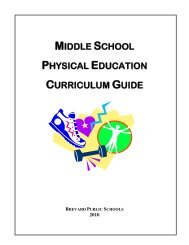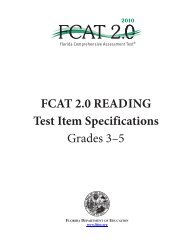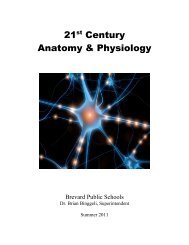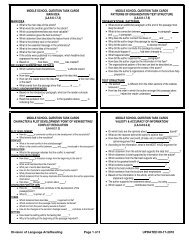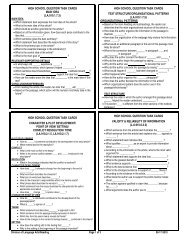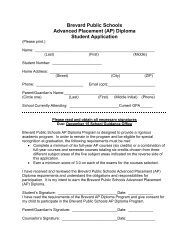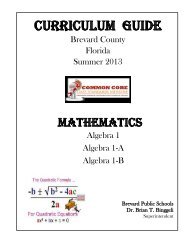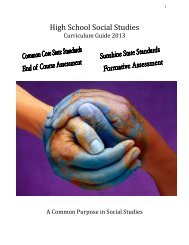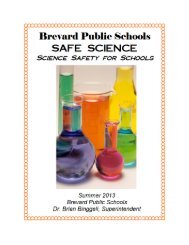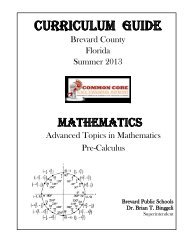Science Research Program Guide - Secondary Programs Home ...
Science Research Program Guide - Secondary Programs Home ...
Science Research Program Guide - Secondary Programs Home ...
Create successful ePaper yourself
Turn your PDF publications into a flip-book with our unique Google optimized e-Paper software.
explanation of what prompted your research, and<br />
what you hoped to achieve.<br />
c) Materials and Methods: Describe in detail the<br />
methodology you used to collect data, make<br />
observations, design apparatus, etc. Your report<br />
should be detailed enough so that someone would<br />
be able to repeat the experiment from the information<br />
in you paper. Include detailed photographs or<br />
drawings of self-designed equipment. Only include<br />
this year’s work.<br />
d) Results: The results include data and analysis.<br />
This should include statistics, graphs, pages with<br />
your raw collected data, etc.<br />
e) Discussion: This is the essence of your paper.<br />
Compare your results with theoretical values,<br />
published data, commonly held beliefs, and/or<br />
expected results. Include a discussion of possible<br />
errors. How did the data vary between repeated<br />
observations of similar events? How were your<br />
results affected by uncontrolled events? What<br />
would you do differently if you repeated this<br />
project? What other experiments should be<br />
conducted?<br />
f) Conclusions: Briefly summarize your results. State<br />
your findings in relationships of one variable with<br />
the other. Support those statements with empirical<br />
data (one average compared to the other average, for<br />
example). Be specific, do not generalize. Never<br />
introduce anything in the conclusion that has not<br />
already been discussed. Also mention practical<br />
applications.<br />
g) Acknowledgments: You should always credit those<br />
who have assisted you, including individuals,<br />
businesses and educational or research institutions.<br />
h) References/Bibliography: Your reference list<br />
should include any documentation that is not your<br />
own (i.e. books, journal articles, websites, etc.). See<br />
an appropriate reference in your discipline for format<br />
or refer to the Instructions to Authors of the<br />
appropriate publication.<br />
Three common reference styles are:<br />
APA (American Psychological Association) Style :<br />
http://apastyle.apa.org/<br />
http://owl.english.purdue.edu/owl/resource/560/01/<br />
This resource, revised according to the 5th edition of<br />
the APA manual, offers examples for the general format<br />
of APA research papers, in-text citations, endnotes/<br />
footnotes, and the reference page.<br />
MLA (Modern Language Association) Format:<br />
http://www.mla.org/style<br />
http://owl.english.purdue.edu/owl/resource/557/01/<br />
This resource, updated to reflect the MLA Handbook for<br />
Writers of <strong>Research</strong> Papers (6th ed.) and the MLA Style<br />
Manual and <strong>Guide</strong> to Scholarly Publishing (2nd ed.),<br />
offers examples for the general format of MLA research<br />
papers, in-text citations, endnotes/footnotes, and the<br />
Works Cited page.<br />
Chicago Manual of Style<br />
http://www.chicagomanualofstyle.org/home.html<br />
The Chicago Manual of Style presents two basic documentation<br />
systems. The more concise author-date system has long been used<br />
by those in the physical, natural, and social sciences. In this<br />
system, sources are briefly cited in the text, usually in parentheses,<br />
by author’s last name and date of publication. The short citations<br />
are amplified in a list of references, where full bibliographic<br />
information is provided.<br />
3) Abstract:<br />
After finishing research and experimentation, you need to write<br />
an abstract. The abstract needs to be a maximum of 250 words<br />
on one page. An abstract should include the a) purpose of the<br />
experiment, b) procedures used, c) data, and conclusions. It also<br />
may include any possible research applications. Only minimal<br />
reference to previous work may be included. The abstract must<br />
focus on work done in the current year and should not include<br />
a) acknowledgments, or b) work or procedures done by the<br />
mentor. See below for an example of an appropriately written<br />
abstract. See page 28 of the International Rules for the proper<br />
formatting of an Official Intel ISEF Abstract and Certification.<br />
Please Note: The Official abstract form is only for those<br />
participating in ISEF and may not be required for many Affiliated<br />
or local fairs.<br />
Sample Abstract<br />
Effects of Marine Engine Exhaust Water on Algae<br />
Jones, Mary E.<br />
<strong>Home</strong>town High School, <strong>Home</strong>town, PA<br />
This project in its present form is the result of bioassay<br />
experimentation on the effects of two-cycle marine engine exhaust<br />
water on certain green algae. The initial idea was to determine the<br />
toxicity of outboard engine lubricant. Some success with lubricants<br />
eventually led to the formulation of “synthetic” exhaust water which,<br />
in turn, led to the use of actual two-cycle engine exhaust water as the<br />
test substance.<br />
Toxicity was determined by means of the standard bottle or<br />
“batch” bioassay technique. Scenedesmus quadricauda and<br />
Ankistrodesmus sp. were used as the test organisms. Toxicity was<br />
measured in terms of a decrease in the maximum standing crop. The<br />
effective concentration - 50% (EC50) for Scenedesmus quadricauda<br />
was found to be 3.75% exhaust water; for Ankistrodesmus sp. 3.1%<br />
exhaust water using the bottle technique.<br />
Anomalies in growth curves raised the suspicion that evaporation<br />
was affecting the results; therefore, a flow-through system was<br />
improvised utilizing the characteristics of a device called a<br />
Biomonitor. Use of a Biomonitor lessened the influence of evaporation,<br />
and the EC 50 was found to be 1.4% exhaust water using<br />
Ankistrodesmus sp. as the test organism. Mixed populations of<br />
various algae gave an EC 50 of 1.28% exhaust water.<br />
The contributions of this project are twofold. First, the toxicity<br />
of two-cycle marine engine exhaust was found to be considerably<br />
greater than reported in the literature (1.4% vs. 4.2%). Secondly, the<br />
benefits of a flow-through bioassay technique utilizing the<br />
Biomonitor was demonstrated.<br />
Patent and Copyright Information<br />
You may want to consider applying for a patent or copyright if you<br />
want to protect your work. You can contact the Office of Public<br />
Affairs, U.S. Patent Office, at 1-800-786-9199 for Patent information or<br />
the Library of Congress at 202-707-3000 for copyright information.<br />
STUDENT HANDBOOK FOR PRECOLLEGE SCIENCE & ENGINEERING PROJECTS - 2008-2009 EDITION



